
Guam is an organized, unincorporated territory of the United States in the Micronesia subregion of the western Pacific Ocean. Guam's capital is Hagåtña, and the most populous village is Dededo. It is the westernmost point and territory of the United States, reckoned from the geographic center of the U.S. In Oceania, Guam is the largest and southernmost of the Mariana Islands and the largest island in Micronesia. As of 2022, its population was 168,801. Chamorros are its largest ethnic group, but a minority on the multiethnic island. The territory spans 210 square miles and has a population density of 775 per square mile (299/km2).
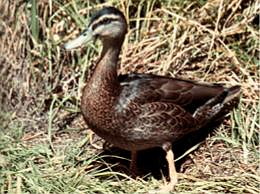
The Mariana mallard or Oustalet's duck is an extinct species of duck of the genus Anas that was endemic to the Mariana Islands. Its taxonomic status is debated, and it has variously been treated as a full species, a subspecies of the mallard or of the Pacific black duck, or sometimes as a subspecies of the Indian spot-billed duck.

Syzygium is a genus of flowering plants that belongs to the myrtle family, Myrtaceae. The genus comprises about 1200 species, and has a native range that extends from Africa and Madagascar through southern Asia east through the Pacific. Its highest levels of diversity occur from Malaysia to northeastern Australia, where many species are very poorly known and many more have not been described taxonomically. One indication of this diversity is in leaf size, ranging from as little as a half inch to as great as 4 ft 11 inches by sixteen inches in Syzygium acre of New Caledonia.
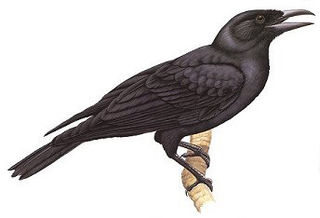
The Mariana crow is a species of the crow family from the tropical Western Pacific. It is a glossy black bird about 15 inches (38 cm) long and known only from the islands of Guam and Rota.
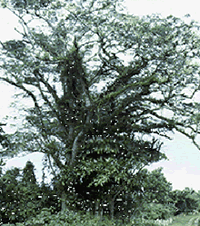
Serianthes nelsonii is a large tree endemic to Guam and Rota of the Mariana Islands. Only one mature tree existed on Guam, while 121 mature trees have been identified on Rota since 1984.

The bridled white-eye is a species of white-eye native to the Mariana Islands and formerly Guam. The species' natural habitat is tropical forests, shrublands and urban areas.

Cycas micronesica is a species of cycad found on the island of Yap in Micronesia, the Marianaislands of Guam and Rota, and The Republic of Palau. It is commonly known as federico nut or fadang in Chamorro. The species, previously lumped with Cycas rumphii and Cycas circinalis, was described as a unique species in 1994 by Ken Hill. Paleoecological studies have determined that Cycas micronesica has been present on the island of Guam for about 9,000 years. It has been implicated as a factor in Lytico-Bodig disease, a condition similar to amyotrophic lateral sclerosis (ALS), due to the presence of the neurotoxin BMAA found in its seeds. Seeds were a traditional food source on Guam until the 1960s. The neurotoxin is present due to a symbiosis with cyanobacteria.

Syzygium hemilamprum, commonly known as the broad-leaved lilly pilly, blush satinash, cassowary gum, Eungella gum, and treated as Acmena hemilampra in New South Wales and Queensland, is a species of flowering plant in the family Myrtaceae and is native to New South Wales, Queensland and the Northern Territory. It is a rainforest tree with broadly lance-shaped to elliptic leaves, panicles of white flowers and more or less spherical white fruit.

Canarium acutifolium is a species of plant in the family Burseraceae, native to eastern Malesia, Papuasia and Queensland.
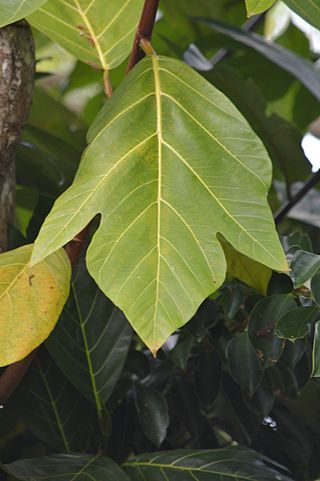
Artocarpus mariannensis, also known as the Marianas breadfruit or the seeded breadfruit, is a species of plant in the mulberry / fig family, Moraceae. It is endemic to the Mariana Islands and Guam. It has been utilized extensively by the Micronesian people, being one of the staple food crops that was introduced to other islands in Micronesia.

Bikkia tetrandra is an herbaceous member of the family Rubiaceae, distinguished by its white square-shaped flowers. It is native to Papuasia and islands of the western Pacific, including the Caroline Islands, Fiji, Mariana Islands, New Caledonia, New Guinea, Niue, Solomon Islands, Tonga, Vanuatu, and Wallis-Futuna Islands. The stems ignite easily and can be used to make torches or candles.
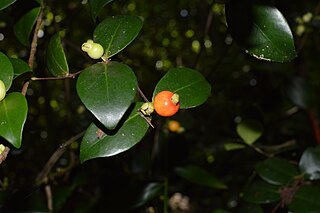
Eugenia palumbis is a shrub with edible fruits in the family Myrtaceae. It is endemic to the Mariana Islands, including Guam and the Commonwealth of the Northern Mariana Islands.

Elaeocarpus joga is a species of tree in the family Elaeocarpaceae. It is native to the Mariana Islands and Palau. It is a moderately-sized tree with blue-coloured, round, 1.5cm diameter fruit and leaves which turn bright red before they senescence.

Gymnosporia thompsonii is a species of plant in the bittersweet family Celastraceae. It is endemic to the Mariana and Caroline Islands, where it grows as a many-stemmed understory shrub or small tree in karst forests. Its wood is used for fuel and its leaves are used medicinally.
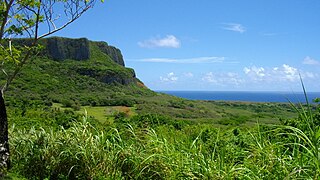
The Marianas tropical dry forests is a tropical and subtropical dry broadleaf forests ecoregion on the Marianas Islands in the western Pacific Ocean.

The Church of Jesus Christ of Latter-day Saints in the Mariana Islands refers to the organization and its members in the Mariana Islands. The Mariana Islands consist of two jurisdictions of the United States: the Commonwealth of the Northern Mariana Islands and, at the southern end of the chain, the territory of Guam. As of December 31, 2022, the LDS Church reported 2,547 members in one stake, five congregations, one mission, and one temple in Guam. There are 906 members in a ward in the Northern Mariana Islands. There are two family history centers, one in Guam and one at the Saipan Ward building in the Northern Mariana Islands.
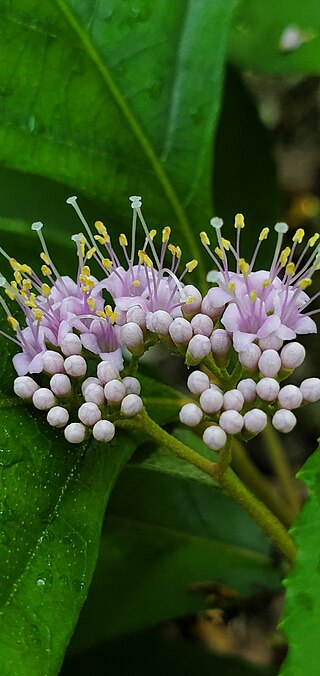
Callicarpa lamii is a plant in the mint family that is endemic to the Mariana Islands. It is one of two Callicarpa plants endemic to the Mariana Islands, the other being Callicarpa candicans var. paucinervia.

Syzygium puberulum, commonly known as white satinash or downy satinash, is a plant in the family Myrtaceae which is native to rainforests of Cape York Peninsula, Queensland, and Papua New Guinea. It was first described in 1942.

Glochidion marianum is a species of plant in the family Phyllanthaceae that is endemic to the islands of Guam and the Caroline Islands.

























